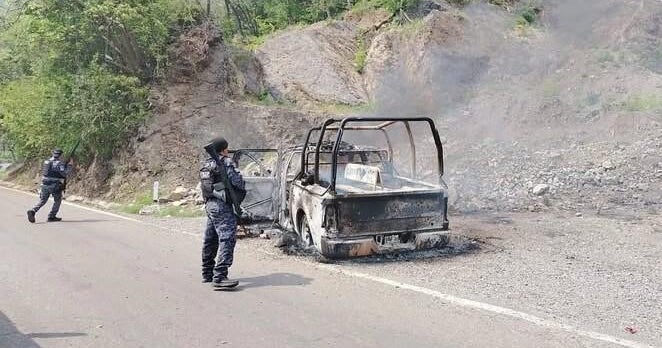| Article Subheadings |
|---|
| 1) Overview of the Attack |
| 2) Identification of Officers |
| 3) Government Response |
| 4) Context of Violence in Chiapas |
| 5) Broader Implications |
In a tragic incident on Monday, five police officers were killed during an ambush by an armed group in Chiapas, a state in southern Mexico bordering Guatemala. The attack occurred while the officers were on patrol in the town of Frontera Comalapa. Local authorities are now investigating the incident, which comes amidst an ongoing violent struggle between major drug cartels in the region.
Overview of the Attack
The ambush in Frontera Comalapa took place when the Chiapas state police officers were out on their regular patrol duties. They were unexpectedly attacked by members of an armed group, leading to the deaths of five officers. The Governor of Chiapas, Eduardo Ramirez, provided updates through social media, confirming the nature of the attack and expressing condolences for the fallen officers. This incident highlights the precarious security situation in the region, where law enforcement frequently faces violent reprisals from organized crime.
Identification of Officers
In the aftermath of the ambush, Governor Ramirez identified the police officers who lost their lives. The officers were named as Guillermo Cortés Morales, Jesús Sánchez Pérez, Joel Martínez Pérez, Brenda Lizbeth Toalá Blanco, and Pedro Hernández Hernández. The loss of their lives marks yet another grim chapter in the ongoing violence that has afflicted law enforcement personnel in Mexico, particularly in potential conflict zones where drug trafficking is rampant. Their deaths not only represent a personal loss for their families but also serve as a stark reminder of the dangers faced by law enforcement in regions heavily influenced by cartel violence.
Government Response
In response to the ambush, the local Security Secretariat announced that more than 1,000 officers had been deployed to the area to bolster security and manage the situation. They are also investigating the attack, following reports that a suspect was apprehended shortly after. The individual, believed to have connections to the ambush, was found hiding near the crime scene, equipped with an AK-47 rifle and military-style uniforms. The authorities have not disclosed information on additional suspects. This rapid response indicates the state’s urgency to contain the escalating violence and prevent further attacks against police and civilians alike.
Context of Violence in Chiapas
Chiapas has been increasingly embroiled in a violent power struggle between two of Mexico’s most notorious criminal organizations: the Sinaloa Cartel and the Jalisco New Generation cartel. This region has been identified as a significant smuggling route not only for drugs but also for migrants seeking passage to the United States. Articulating the past violence, the InSight Crime think tank has described Chiapas as a crucial hub for such illicit activities. The climate of fear and instability has intensified in recent months, with local authorities reporting shocking incidents, such as the discovery of over 30 bodies buried in clandestine pits just last December.
Broader Implications
The implications of this ongoing violence are manifold, affecting not only law enforcement’s operational capabilities but also community safety and trust in the government. Such ambushes increase the propensity for further attacks, prompting law enforcement to adopt more aggressive strategies. The killings of police officers can lead to a chilling effect on police morale and community-police relations, jeopardizing public safety and trust. The situation also places pressure on state and national governments to devise effective strategies to combat the pervasive influence of drug cartels in regions such as Chiapas, where local populations are often caught in the crossfire of violent turf wars.
| No. | Key Points |
|---|---|
| 1 | Five police officers were ambushed and killed in Chiapas, Mexico, highlighting the risks faced by law enforcement. |
| 2 | The slain officers were identified as part of the Chiapas state police, emphasizing the human cost of cartel violence. |
| 3 | More than 1,000 officers were deployed to enhance security in the region following the attack. |
| 4 | Chiapas is experiencing a violent turf war between the Sinaloa and Jalisco New Generation cartels. |
| 5 | The ongoing violence challenges community safety and trust in law enforcement and government efforts to combat crime. |
Summary
The tragic ambush of police officers in Chiapas underscores the violent reality faced by law enforcement in regions plagued by drug cartels. Their deaths reflect the larger context of insecurity in Mexico, where organized crime continues to wield significant influence over local populations. The government’s immediate response and increased law enforcement presence signals an attempt to regain control, yet the broader implications of such violence pose ongoing challenges for both the community and authorities.
Frequently Asked Questions
Question: What prompted the ambush of the police officers in Chiapas?
The ambush was part of an ongoing conflict between rival drug cartels, specifically between the Sinaloa and Jalisco New Generation cartels, who are vying for control in the region.
Question: What measures is the government taking following the attack?
In response to the attack, the government has deployed more than 1,000 police officers to ensure security and investigate the incident, aiming to prevent further violence.
Question: How has organized crime affected local communities in Chiapas?
Organized crime has created an environment of fear and instability in local communities, leading to increased violence and distrust towards law enforcement, complicating efforts to ensure public safety.
